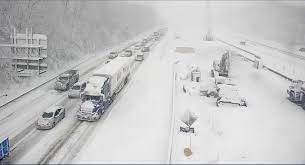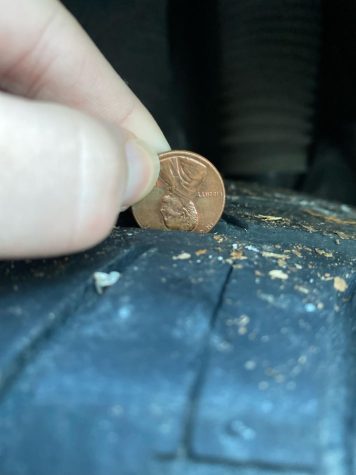Warning for Driving in Winter Weather

I-95 through Northern Virginia was at a standstill due to winter weather on Jan 3.
January 27, 2022
On Monday, Jan. 3, a winter storm pelted Northern Virginia. After an accident blocked I-95, drivers were stuck in ice and snow for hours, some for almost a whole day. Last week, winter weather struck again, coating roads across Rockbridge County in a hazardous mixture of snow and ice.
Given these recent severe conditions, it is important for drivers to know how to drive in winter weather in order to stay safe. In the past couple weeks there has been ice and snow covering the roads that drivers, especially new drivers, should know how to navigate safely.
Michelle Kirby, A Driver’s Education teacher at RCHS, offered some advice. In particular, she emphasized preparing for the weather by knowing how to take care of your car, starting with your tires.
“In cold weather, keep an eye on your tires. Make sure your tires are in good condition and the tread isn’t too worn,” said Kirby.
Because of the cold temperatures, the air inside tires condenses, decreasing the tire pressure. When tire pressure decreases, the tread of the tire is not able to be as effective at gripping the road, which is dangerous for driving on snow and ice. Low tire pressure can also cause tires to become damaged or even blow out, which could be detrimental while driving.
“If you have a car built after 2008, you’ll have a tire pressure light that comes on when your pressure is low. If that happens, add air to your tires,” said Kirby.
Air for tires is often available at gas stations, so it is an easily remedied problem as long as it is addressed as soon as possible. A helpful way to check tire pressure is the penny test. If you put a penny in between the treads of your tire with Lincoln’s head facing upside down, the tire pressure is correct if part of his face is covered.

Next, you should ensure that the windshield wiper fluid in your vehicle is appropriate for the weather. Since windshield wiper fluid is necessary with all the precipitation of rain and snow, the fluid has to be able to withstand freezing temperatures.
“If your windshield washer fluid isn’t All Weather or appropriate for winter, change it out,” said Kirby. “It will keep it from freezing on your windshield.”
Even the salt put down on the road can cause damage to your car.
“All the salt and stuff on the road is rough on your vehicle. Spray it off when you can, especially the undercarriage,” said Kirby.
Lastly, it is important to care for your vehicle’s battery. Batteries are weaker in the winter because the chemical reaction taking place within it is slowed by the cold.
“Check the age and condition of your battery. If it’s older, you may need to get a new one,” said Kirby. “Batteries drain faster in colder weather so if you need a new one, don’t be surprised if your car doesn’t want to start.”
Even with all these precautions, car’s are not simply immune to the weather. It is important to think about what conditions you may face while driving and allow extra time in your trip to counteract that.
“Drive slow and take your time,” said Kirby, “Keep in mind, it doesn’t matter what type of vehicle you’re driving in snow or ice. You have to have traction to stay on the road and not wreck. A large truck or SUV can lose traction the same as a small car if you’re driving too fast for the conditions.”
Despite following all recommendations and taking care of your vehicle, something could still happen. That’s why it is recommended to keep some essentials in your car at all times.
“It’s recommended to keep an emergency kit in your vehicle complete with jumper cables, blankets, flares, flashlights, and scrapers and brushes,” said Kirby, “The one thing people tend to forget about is water and non-perishable food as well.”
And, as unlikely as it is, in case you do get caught in a situation like that on I-95, there are some procedures you should follow.
“Cut off your vehicle to preserve fuel. You can cut it back on as needed to warm up your car a bit, but mostly you should keep it cut off,” said Kirby, “You’ll have food and water from your emergency kit, but ration it as much as you can to last as long as possible.”
“If snow piles up around your vehicle, you will need to clear out around your vehicle before cutting it back on,” said Kirby, “If the exhaust is covered, with no place for the fumes to escape, you’ll end up with carbon monoxide poisoning which can lead to death.”
So, while the issue on I-95 was extreme, incidents happen without warning, so it’s much better to be prepared, especially for young drivers.
“Failure to drive with caution during bad weather or not maintaining your vehicle could result in a crash. While some may be minor fender benders, others could be significant crashes that could kill you or others,” said Kirby.







